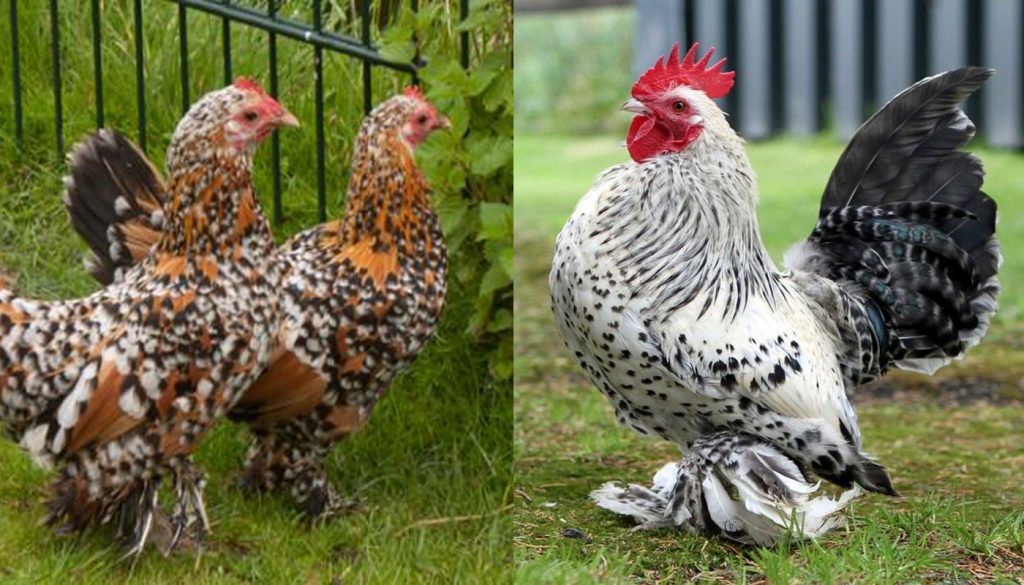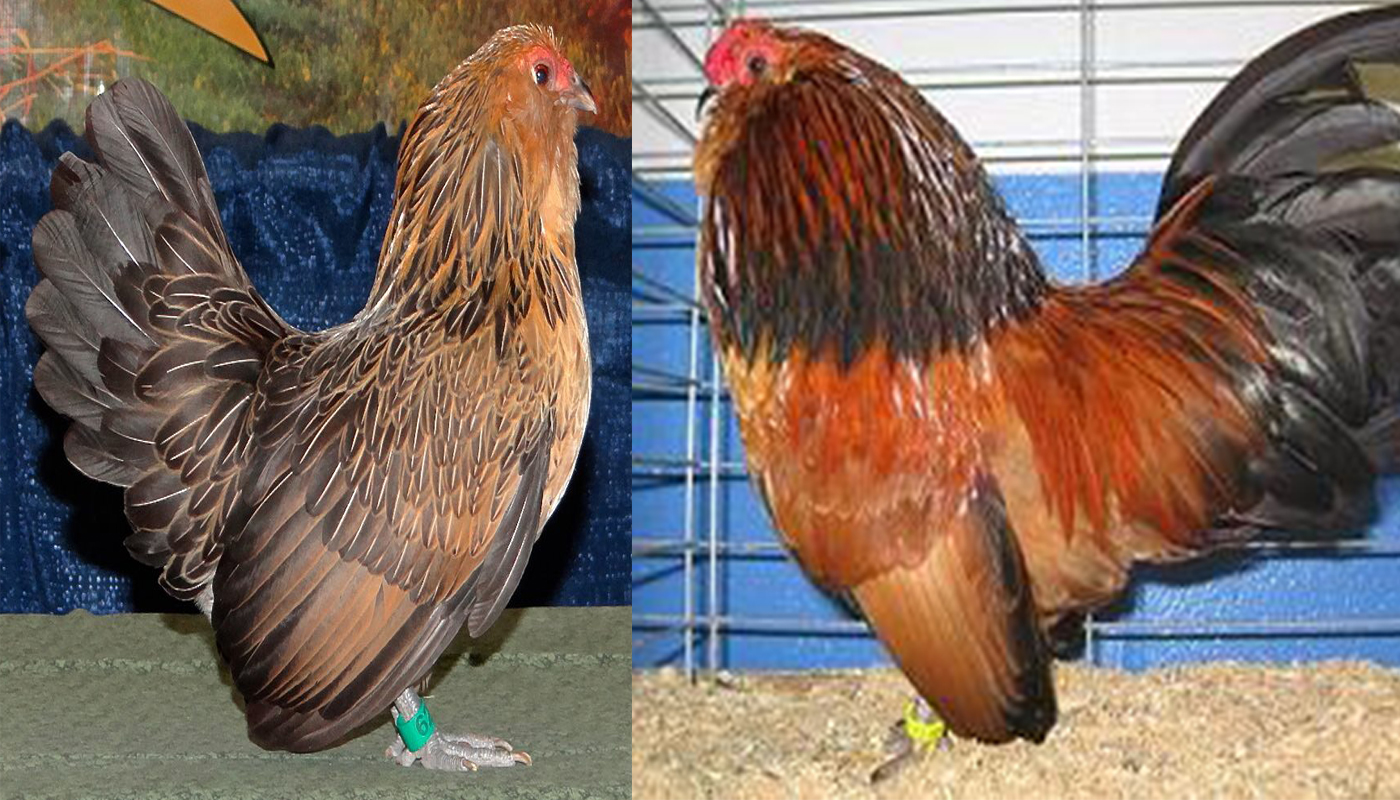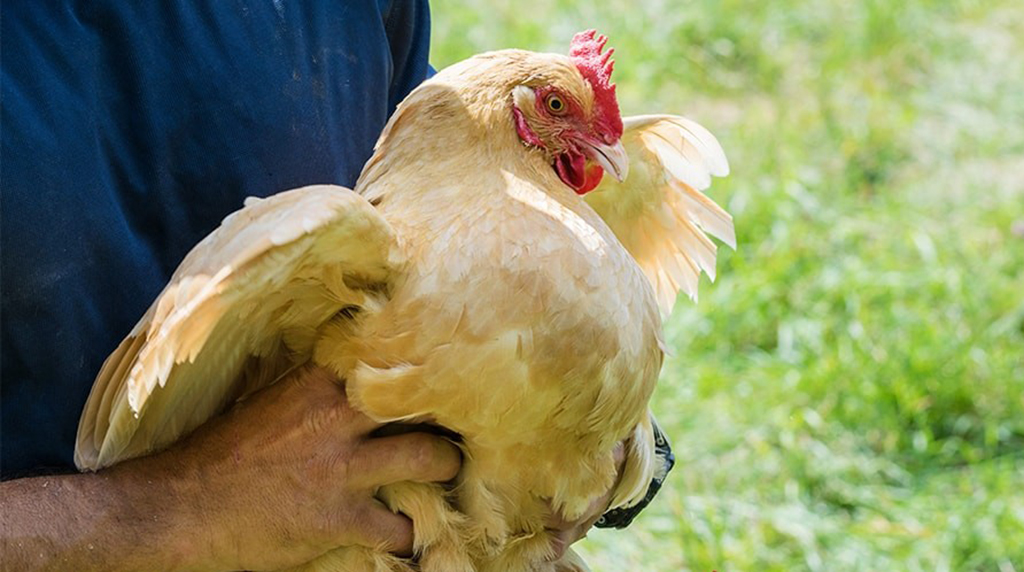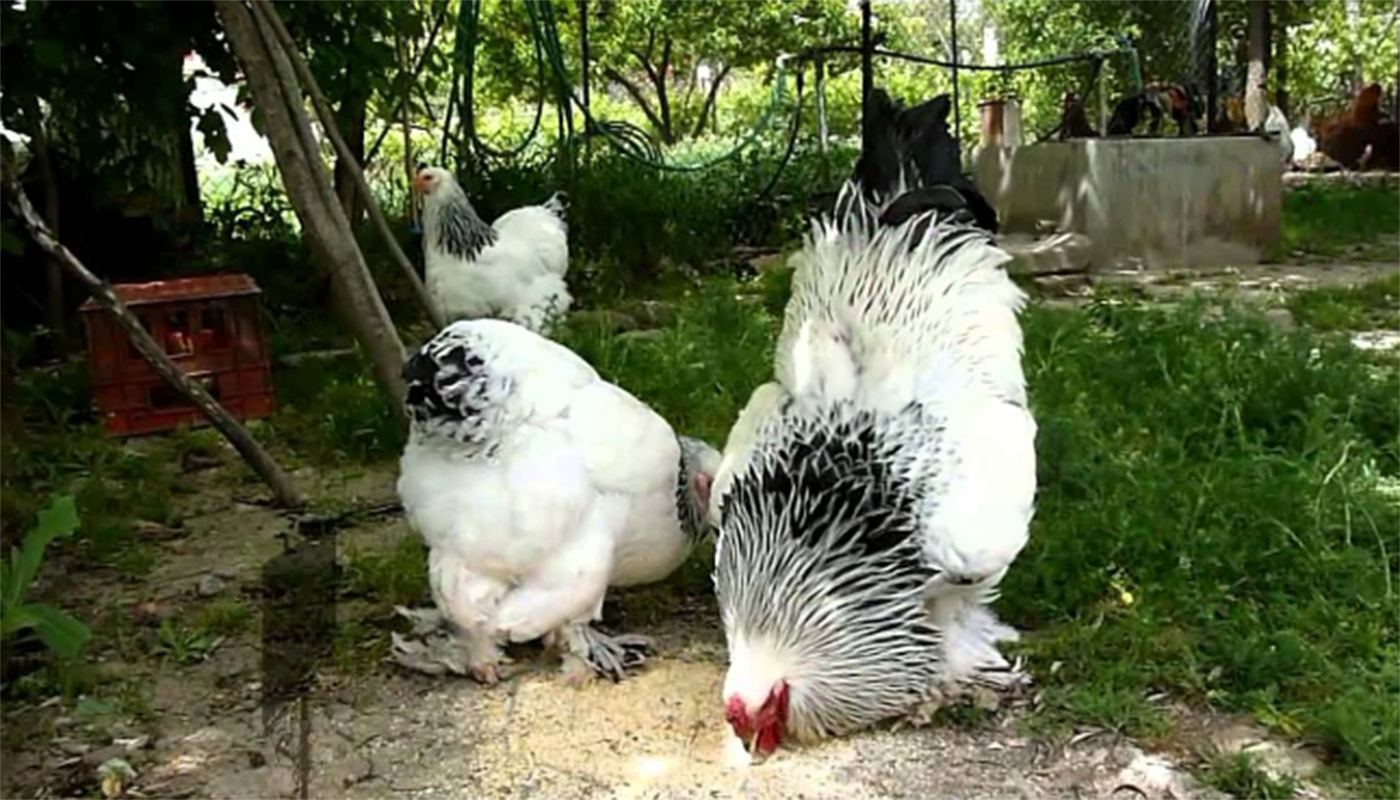
The Booted Bantam is one of the oldest and rare true Bantam breeds. Its name comes from it’s up to six-inch-long feathers that cover its feet and hock joints. These are called vulture hocks or in Dutch they are called sabels and that is why the bird is called Sablepoot in Dutch.
They are small chickens with the largest of the males rarely getting bigger than about 30 ounces whilst the females rarely top 27 ounces.
The American Poultry Society standards state that the male birds should not be any bigger than 26 ounces and the females 22 ounces.
The Booted Bantam has large downward pointing wings, with broad breasts and backs, profuse plumage and single upright combs. These birds have been kept by breeders for centuries and their docile, friendly and calm nature makes them exceptionally good pets especially for people with small children.
They are quite good layers, but their eggs are tiny and white not too good to eat unless for a delicacy but they hens are exceptional brood hens, so they make good breeding hens.
Because they are quite susceptible to climate and disease they are quite a high maintenance chicken so not advisable for a first-time chicken owner. They are also more of a pet, show or breeding chicken and would not make a decent meal as they a too small.
| Country of Origin: | Netherlands |
| American Poultry Association: | Recognized as a breed of chicken in the United States |
| Chicken Category: | Bantam |
| You may Also Like: | TOP 10 BANTAM CHICKEN BREEDS FOR BEGINNERS |
| Chicken Class: | Feathered Legged (Rare true Bantam) |
| Bantam Variety Available? | There is only a Bantam breed |
| Good Starter Chicken? | They are not a good starter chicken |
IDENTIFICATION⇒ |
Appearance/Body: They have a full upright tail, a short compact
body, prominent breast, long wings and vulture hocks. Red wattles, earlobes and upright comb
Color(s) There are over twenty different colors some of the recognized and more popular colors are Barred, Blue, Buff, Cuckoo, Gray, Golden Neck, Lemon Mille Fleur, Porcelain, Black, Mottled, Partridge, Lavender, white, Silver Mille Fleur and Self-Blue.
Comb: They have a single comb
Ave. Weight: Hens/Pullet 22 Ounces.
Cockerels/Roosters 26 Ounces. |
PURPOSE⇒ |
Eggs: They are quite good egg layers.
They lay very/extra small (Bantam sized) white eggs about 150 – 180 per year They are steady layers, laying consistently all year around. They start to lay eggs from around 22 weeks old.
Meat: They are too small to make good table/meat chickens.
Breeding: Hens get very broody making them excellent brood hens.
If you are breeding Booted Bantams for show choosing the correct hens and rooster bloodline is crucial. They make the cutest baby chicks with fluffy feet which looks like they have slippers on. For advice on breeding please check our guide to breed poultry. If you are a first-time breeder it is best to get professional advice from your local animal shelters, poultry farmers, breeders club or vet.
Foraging: They love to scratch and forage about. They are a bird that will love to garden with you.
Show Bird: Booted Bantams are referred to as the “Super Models” of chickens. They are exceptional show birds.
Pets: They make wonderful pets
Other: These gorgeous chickens take to confinement well and most breeders/owners keep them inside or have special soft bedding to look after their feathers.
|
HISTORY
Being closely related to the Belgian Bearded d’Uccle and sharing a few color groups these little birds are often mistaken for them. There are, however, differences one major one being the Booted Bantam has no beard or ear muffs but the Bearded d’Uccle does.
Another likeness these two Bantam breeds share is their Vulture Hocks that are not found in many chicken breeds.
This breed was accepted into the American Poultry Association Standards of Perfection in 1879 and has been a popular Bantam breed across Europe for hundreds of years.
It is classed as a Feather Legged group and recognized by the American Bantam Association.
There are many different colors that are accepted by the various associations around the world with more being added over the years.
CHARACTERISTICS |
|
|---|---|
| Life Expectancy: | The average lifespan is up to 10 years. |
| Health: | They are susceptible to the heat and cold as well as Marek’s disease. They are not very hardy birds and need constant attention and care to keep them healthy. |
| Temperament: | They are sweet, tame, intelligent docile birds that are a constant delight to have around the house and or garden. |
| Flyers? | They are exceptionally good strong flyers and do love to fly. |
| Noisy Birds? | They are not too noisy |
| Interaction with other chickens: | They get along with most other breeds and are generally calm accepting birds. As with any flock if you are introducing new birds it is best to slowly socialize them with the flock. |
| Good with kids? | These birds are a really good breed to have for supervised children of all ages. |
| Socialize Behavior? | They get along well with all other animals although they tend to shy away from most animals as they are small. |
| Known predators: | As they are small chickens it is best not to leave them unsupervised around other domestic animals especially dogs and cats. If hawks and or foxes are in your area it is always best to take precautions. Check with local animal shelters, zoos, vets, animal control and or pet stores about common predators in your area. |
| Conservation Status: | They are a rare breed but not on the conservation list. Checking on domestic animals conservation status can be done at the national conservation centers or checking their website. |
IDEAL ENVIRONMENT |
|
|---|---|
| Garden Size: | They adapt well to any garden size although it is best to keep them in a large chicken run or inside. |
| Ideal Climate: | Not weather hard birds and have to be maintained in both heat and cold. |
| Ideal Coop: | The rule of thumb for any coop is 50 cm x 50 cm per hen/rooster in the coop. Ensure there is a good space for the nesting boxes and nightly roosting rails at least 1.5 inches wide. Good ventilation for air but not too drafty especially in winter. It is always a good idea to raise the coop off the ground to give the birds a dry place to roost and lay especially in wet weather. |
| Ideal Coop Run: | The coop run should be completely covered, and the entire coop should be inside the house or barn type structure. They are excellent and powerful flyers that do love to fly and roost on the highest branches, so precautions have to be taken. |
| Ideal Flock Size: | There is safety in numbers and all chickens like to socialize and be part of a flock larger than two or three. |
| Special Instructions: | There feathers have to be kept dry and may need a trimming. |
| Accessories: | The following accessories are ideal for your coop: Nesting boxes Straw for the boxes and roosting area Roosting rails Perches Water troughs/bowls Food bowls/feeders Heating lamp(s) Animal carrier for transport purposes |
| You may Also Like: | 45 FREE DIY CHICKEN COOP PLANS, TUTORIALS AND DESIGNS |
WHERE TO FIND THESE BIRDS TO ADD TO YOUR FLOCK
These Bantam chickens are becoming more and more popular throughout the world. As such there are constantly being new colors bred it is always best to ensure you buy your Booted Bantams from a registered dealer. These can be found by searching the internet or visiting the Booted Bantam Club this also ensure that you are getting true Booted Bantams with registered bloodlines.
They can still be found at most live poultry outlets and farms as well only they may not be recognized Standard of Perfection specifications, so you will not be able to show the birds or breed them as a true Booted Bantam breed. If you plan on breeding your chickens, you will want to make sure that they are from a good bloodline.
Registered breeders and Booted Bantam registered clubs will also be able to help with any special requirements, attention or care these Bantams may need.
CARING FOR THE BIRD(S)
Please click here for our full guide to “Taking care of chickens”. This is a comprehensive guide to owning chickens. It covers where to start from choosing your ideal flock, the coop that would best suit your garden, your bird and you to buying and bringing your bird(s) home.
GENERAL
These ladies may need a bit more attention than other chickens, but they are still truly amazing to have around the house and or garden. They become part of the family, they love the attention and are really easy to handle as they are calm tame birds.
GROOMING
These ladies, like any other chickens, do love their dust bath as they too need to get rid of excess oil build up on their gorgeous plumes and shake off pests. It is a good idea to regularly check them for mites, lice and various other parasites at least once a week. You must get your birds de-wormed on a regular basis especially if they are around other animals or interacting with kids.
DIET AND NUTRITION
Although these Bantams are partial to fruit and vegetable table scraps it is best to feed them their usual chicken feed first thing in the morning. As with other chickens, they will eat chicken pellets, grains, chicken mash or grain mix from 8 weeks old and older.
For baby chickens, the best is always Chick Starter when they are under 8 weeks old.
Laying hens should get extra protein and calcium in their diets to ensure the quality of their eggs and to keep them in tip-top health.
Please see our comprehensive guide to “Feeding your chickens” for more information of the different types of chicken feed for chicks, hens, laying hens, roosters, etc. and where to buy the feed and approximate cost of the feed.
SOCIALIZING THE BIRD(S)
It is best to keep in mind the size of these birds if you are thinking of adding to your flock. As they tend to be quite docile it is best to introduce birds of a similar docile calm nature especially if introducing larger chicken breeds.
Always check on how well a breed will get on with your current flock before buying them as you do not want to upset your coop or stress your current flock.
As with any newcomer to the roost, you will have to quarantine the bird for 7 – 31 days to ensure it does not have any unwanted critters or disease that could spread to your current flock. Make sure your Booted Bantams have had all their shots and their health is good before adding any other chicken to your coop.
Even though they are friendly sociable birds, even they have a pecking order, so it is advisable to socialize newcomers slowly and determine when it is right to allow them to become a permanent part of the flock.
NOTES / SPECIAL INSTRUCTIONS
These birds can get feet problems if their foot feathers get wet, they are more susceptible to the weather and disease than other chickens. Seek advice from professionals or experienced breeders/Booted Bantam owners. For advice on what the bird’s conservation status and orders are please check with your local conservation department.
For breeders, it is imperative that you always check your bird’s bloodlines and ensure you are buying your birds from a reputed breeder/farm. In order to sell birds of such stature, they have to be recorded and documented, always check with local animal breeding organizations for these records.
These legitimate documents are also required should you wish to show your bird(s) in various poultry shows/competition showings.
For information and advice on adopting rescued animals, you can visit or contact your local animal welfare center.
Video
USEFUL LINKS
- Caring for your Chicken
- Feeding
- Health
- Socializing your Chicken
- Breeding Chicken
- Raising Chickens A-Z
- Hatching Eggs
- What is Molting
- Animal Shelter (ASPCA)
- American Veterinary Medical Association
- American Poultry Association
- American Animal Welfare Society
- American Animal Control
- American Animal Husbandry Society
References
- https://en.wikipedia.org
- https://livestockconservancy.org
- https://www.roysfarm.com
- https://www.mypetchicken.com
- https://www.backyardchickens.com
- https://www.feathersite.com/
 ISA Brown Chicken Breed – Everything You Need to Know
ISA Brown Chicken Breed – Everything You Need to Know Ancona Chicken Breed – Everything You Need to Know
Ancona Chicken Breed – Everything You Need to Know GETTING READY TO HATCH THE EGGS – HATCHING EGGS PART 3
GETTING READY TO HATCH THE EGGS – HATCHING EGGS PART 3 10 of the Most Rare Chicken Breeds
10 of the Most Rare Chicken Breeds Cochin Chicken Breed – Everything You Need to Know
Cochin Chicken Breed – Everything You Need to Know 10 of the Smallest Chicken Breeds
10 of the Smallest Chicken Breeds Australorp Chicken Breed – Everything You Need to Know
Australorp Chicken Breed – Everything You Need to Know Why Deworming Chickens is Important?
Why Deworming Chickens is Important? The Top 10 Backyard Chickens to suit any Coop or Garden Size
The Top 10 Backyard Chickens to suit any Coop or Garden Size CONDITIONS THAT AFFECT THE EYES OF A CHICKEN
CONDITIONS THAT AFFECT THE EYES OF A CHICKEN Sicilian Buttercup Chicken Breed – Everything You Need to Know
Sicilian Buttercup Chicken Breed – Everything You Need to Know 10 Chicken Breeds that do well among other Chicken Breeds for a Mixed Flock
10 Chicken Breeds that do well among other Chicken Breeds for a Mixed Flock